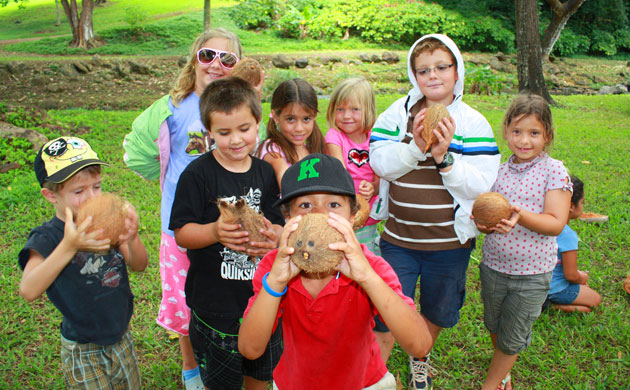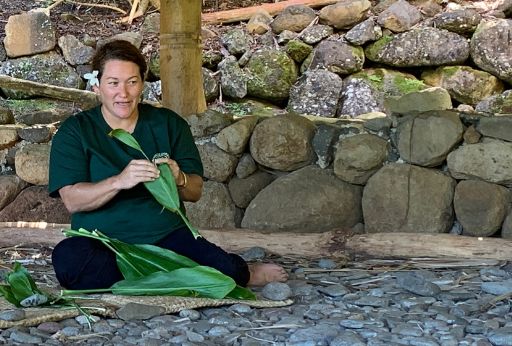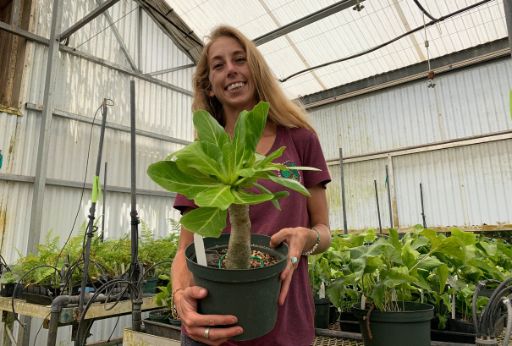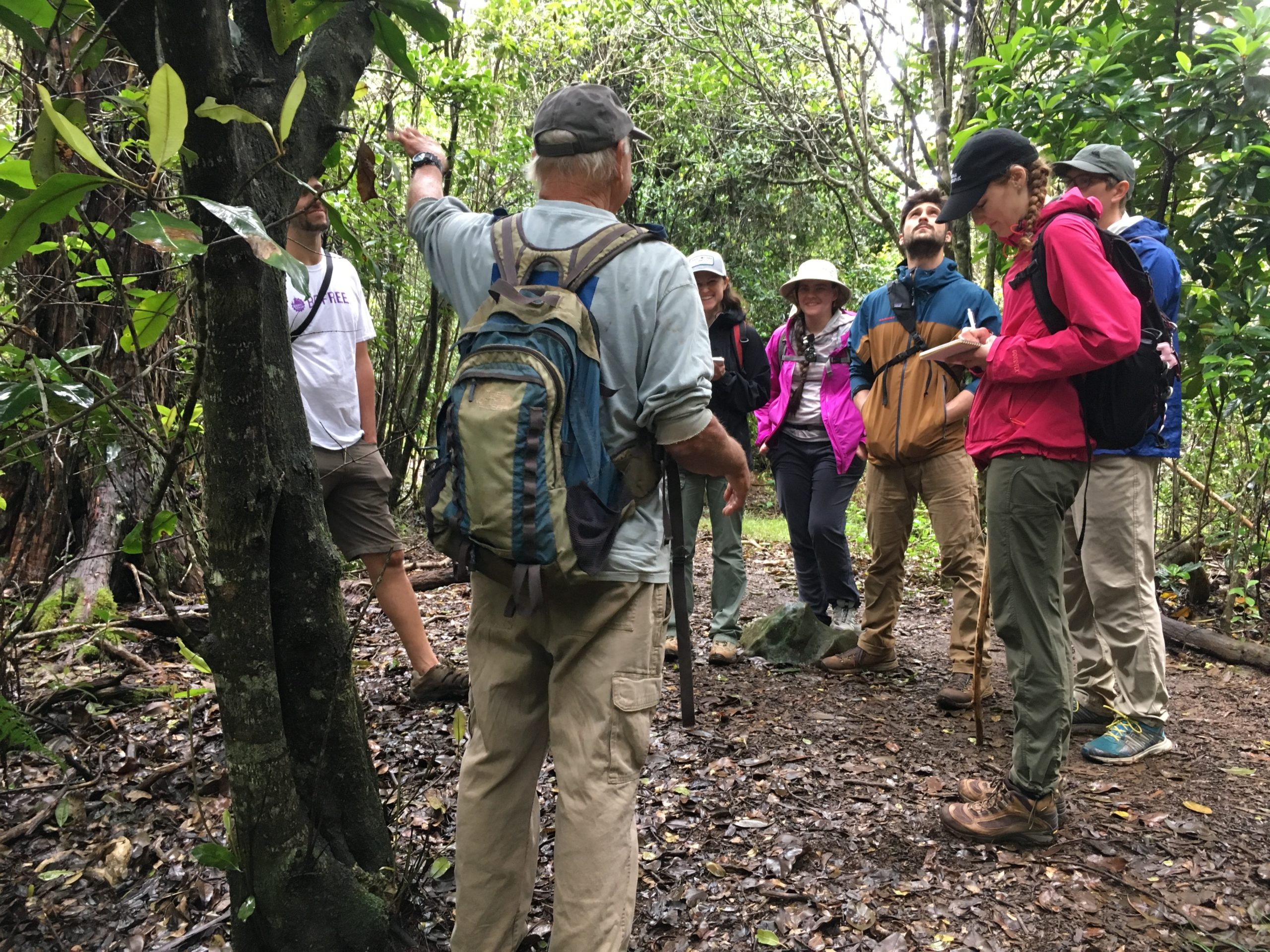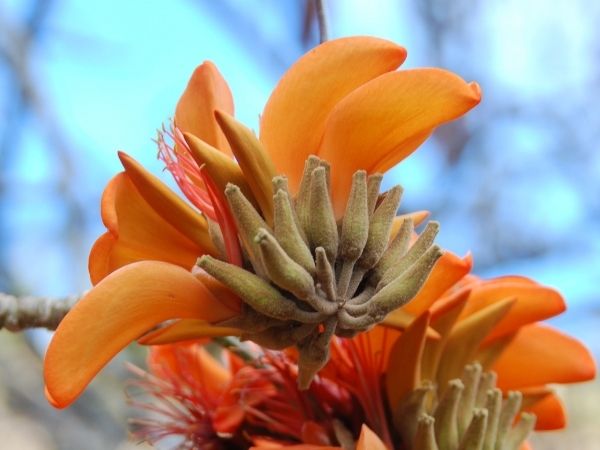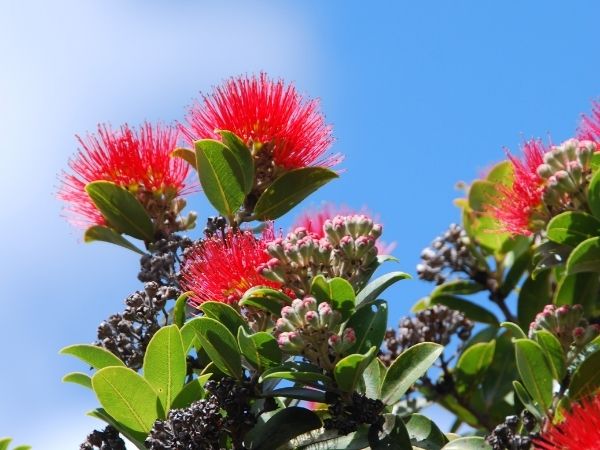Tropical Plant Database - Plant Details
Plumbago zeylanica
Click on any heading above to view more information about this plant
Conservation Status
- IUCN: Not Evaluated
- USFWS: None
Family: PLUMBAGINACEAE
Genus: Plumbago
Species: zeylanica
Species Author: L.
Vernacular: Ilie'e, Hilihe'e, 'ilihe'e, Lauhihi [Niihau], Leadwort
Genus: Plumbago
Species: zeylanica
Species Author: L.
Vernacular: Ilie'e, Hilihe'e, 'ilihe'e, Lauhihi [Niihau], Leadwort
Plumbago zeylanica, known in Hawaii by the common name ‘Ilie‘e, is a shrub that spreads extensively with stems that grow up to 2.5 m long. The leaves are ovate with short lobes at their base and can grow up to 12.5 cm long and 5 cm wide but are more commonly smaller in size. The flowers are produced along a stalk that is 6-30 cm long and the stalk is covered with glandular hairs, which give it a sticky coating. The calyx at the base of the flower forms a narrow tube and is also covered in long glandular hairs. The white petals are fused into a tube that is 18-23 mm long and have five lobes that spread widely. The stamens are inserted into the tube formed by the petals. The fruit is a dry capsule, which splits along a line of weakness at the base of the fruit at maturity. The capsules are 4-5 mm long and contains many small dark purple seeds.
(Wagner, W. L., Herbst, D. R., and S. H. Sohmer. 1999. Manual of the Flowering Plants of Hawai‘i. Revised Edition. Volume 2. Bishop Museum Special Publication 97. University of Hawai`i Press, Bishop Museum Press, Honolulu, Hawai’i.)
(Wagner, W. L., Herbst, D. R., and S. H. Sohmer. 1999. Manual of the Flowering Plants of Hawai‘i. Revised Edition. Volume 2. Bishop Museum Special Publication 97. University of Hawai`i Press, Bishop Museum Press, Honolulu, Hawai’i.)
In England the roots and bruised seeds of Common plumbago (Plumbago europaeae) were used for the treatment of toothache. The root of this species contains plumbagine which has antibiotic properties and was applied externally to treat “swellings”. In Asia Plumbago is applied externally as a poultice for the treatment of rheumatism, leprosy, tumors, and ringworm. A recent study investigated the potential of a root extract from Plumbago zeylanica as an antiarthritic and suggests that the extract suppressed the anti-collagen antibody response in mice.
(Poosarla, A., B.V. Kumar, T.R. Rao, D.N. Rao, and R.R. Athota, 2007. Alleviation of collagen-induced arthritis by Plumbago zeylanica in Mice. Pharmaceutical Biology 45(1): 54-59.)
Lewis, W.H. and M. P.F. Elvin-Lewis. 2003. Medical Botany: Plants Affecting Human Health. John Wiley & Sons, Inc., Hoboken, NJ.)
(Poosarla, A., B.V. Kumar, T.R. Rao, D.N. Rao, and R.R. Athota, 2007. Alleviation of collagen-induced arthritis by Plumbago zeylanica in Mice. Pharmaceutical Biology 45(1): 54-59.)
Lewis, W.H. and M. P.F. Elvin-Lewis. 2003. Medical Botany: Plants Affecting Human Health. John Wiley & Sons, Inc., Hoboken, NJ.)
All parts of Plumbago contain the alkaloid plumbagine which can be poisonous both applied externally and taken internally. The sap is irritant and causes blistering when applied to the skin. Plumbago zeylanica is considered to be less poisonous than other species.
(Neal, M.C. 1965. In Gardens of Hawai‘i. Bishop Museum Press, Honolulu, HI.)
(Neal, M.C. 1965. In Gardens of Hawai‘i. Bishop Museum Press, Honolulu, HI.)
The juice from the roots of ‘Ilie‘e were traditionally used in Hawai‘i to provide blue to black coloration for tattoos. The native Iris mau‘u la‘ili (Sisyrinchium acre), the Kukui (Aleurites moluccana) fruit and seed, Sugar cane or Ko stems (Saccharum officinarum), and were also used to produce blue to black pigment.
(Abbott, I A. 1992. La‘au Hawai‘i: Traditional Hawaiian Uses of Plants. Bishop Museum Press, Honolulu, Hawai’i.)
(Abbott, I A. 1992. La‘au Hawai‘i: Traditional Hawaiian Uses of Plants. Bishop Museum Press, Honolulu, Hawai’i.)
‘Ilie‘e is native to Old World tropical regions including the Pacific and Hawaiian Islands. It is found in open, high sunlight, exposed habitats including coastal strand, dry forest, and shrubland. In Hawaii this species is found on all the main islands below 610 m elevation. The genus Plumbago contains 10 species in tropical and subtropical regions.
(Wagner, W. L., Herbst, D. R., and S. H. Sohmer. 1999. Manual of the Flowering Plants of Hawai‘i. Revised Edition. Volume 2. Bishop Museum Special Publication 97. University of Hawai`i Press, Bishop Museum Press, Honolulu, Hawai’i.)
(Wagner, W. L., Herbst, D. R., and S. H. Sohmer. 1999. Manual of the Flowering Plants of Hawai‘i. Revised Edition. Volume 2. Bishop Museum Special Publication 97. University of Hawai`i Press, Bishop Museum Press, Honolulu, Hawai’i.)
The name Plumbago is derived from the Latin words plumb meaning lead and agre to convey. This may be a reference to the gray coloration left on the hands after handling the root. The Hawaiian name Hilie‘e is derived from the word hili meaning “to stain dark brown” in reference to the use of this plant for blue or black pigment in traditional tattoos.
(Neal, M.C. 1965. In Gardens of Hawai‘i. Bishop Museum Press, Honolulu, HI.)
(Staples, G. W. and D. R. Herbst. 2005. A Tropical Garden Flora: Plants cultivated in the Hawaiian Islands and other tropical places. Bishop Museum Press, Honolulu, Hawai’i.)
(Neal, M.C. 1965. In Gardens of Hawai‘i. Bishop Museum Press, Honolulu, HI.)
(Staples, G. W. and D. R. Herbst. 2005. A Tropical Garden Flora: Plants cultivated in the Hawaiian Islands and other tropical places. Bishop Museum Press, Honolulu, Hawai’i.)
- 017502 - collected by Derral Herbst in 1971
- 017503 - collected by Steven P. Darwin in 1975
- 074605 - collected by Art Whistler in 1975
- 017500 - collected by Tim Flynn in 1987
- 017501 - collected by Lynwood Hume in 1988
- 017499 - collected by Lynwood Hume in 1988
- 002810 - collected by Tim Flynn in 1990
- 006027 - collected by Derral Herbst in 1990
- 005760 - collected by David H. Lorence in 1990
- 013313 - collected by I. A. Abbott & F. M. Norris in 1991
- 074603 - collected by Art Whistler in 1997
- 074604 - collected by Art Whistler in 1997
- 028844 - collected by Steve Perlman in 1998
- 030607 - collected by Steve Perlman in 2000
- 035125 - collected by David H. Lorence in 2001
- 043195 - collected by Liloa Dunn in 2003
- Unassigned - collected by Hank Oppenheimer in 2005
- 061832 - collected by K. R. Wood in 2005
- 051854 - collected by K. R. Wood in 2006
- 065638 - collected by Natalia Tangalin in 2011
- 086224 - collected by J. Soelberg in 2014
- 082280 - collected by K. R. Wood in 2016
- 092653 - collected by Dustin Wolkis in 2022
We currently have 23 herbarium specimens for Plumbago zeylanica in our collection. Click on any specimen below to view the herbarium sheet data.
.svg)




